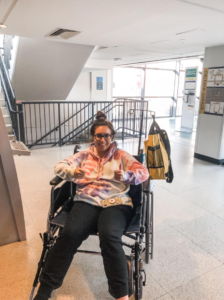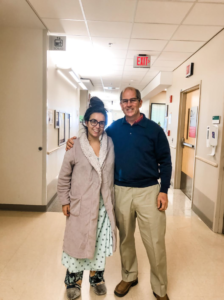April is National Donate Life in America, and it’s a critical time to raise awareness on not only to become an organ donor, but also to learn the stories of those that have received this lifesaving transplants. One of those receipts is Maryland native Meghan Smith, a marketing executive that has used Instagram for our favorite thing…raising awareness, changing misconceptions, and showing how awesome and fun life can be with any health struggles. After a few years of health issues, it was discovered Meghan had liver disease and was in need of a transplant. Luckily, her uncle was a match to donate a portion of his liver! Meghan is such a transparent advocate because she shares the realness of post-transplant life, and all the medications and adjustments you make in life to adapt and excel. There’s no singular way to look or live as a young person with health struggle, and Meghan–who’s now a Donate Life Ambassador–is using her growing platform to give a fresh look on how incredible , fun and fulfilling life can be!
My name is Meghan and I am a 29 year old from Baltimore, MD. I work as a marketing executive for a global affiliate marketing company, and in my spare time enjoy traveling, reading, shopping, playing with my dog and spending time with friends and family. Growing up, I had a fairly normal and typical childhood. I lived in the suburbs outside of Baltimore with my mom, dad and younger brother, was active in dance and softball, and was generally healthy.
 When I was 19 years old, I was studying at the University of Maryland when I started to develop abdominal pain and severe itchiness. I spent most of my college years going to different doctors trying to figure out the cause. Finally, at 22 I met a doctor at Johns Hopkins who determined the issue was caused by my liver. Around this time, my younger brother was 19 and started developing similar symptoms. For whatever reason, his liver disease had progressed much faster and he was in liver failure with liver cancer. He was listed for liver transplant and thanks to the generosity of one of my dad’s previous co-workers, received a living donor liver transplant at the age of 21.
When I was 19 years old, I was studying at the University of Maryland when I started to develop abdominal pain and severe itchiness. I spent most of my college years going to different doctors trying to figure out the cause. Finally, at 22 I met a doctor at Johns Hopkins who determined the issue was caused by my liver. Around this time, my younger brother was 19 and started developing similar symptoms. For whatever reason, his liver disease had progressed much faster and he was in liver failure with liver cancer. He was listed for liver transplant and thanks to the generosity of one of my dad’s previous co-workers, received a living donor liver transplant at the age of 21.
I continued to be monitored by my hepatology team, and while numerous genetic tests were done to try to figure out the cause of our liver disease, there was never a match. In August of 2019 it was determined that it was time for me to be listed for liver transplant. Numerous people kindly reached out about being tested to be my donor. My uncle was the first person to undergo testing, and surprisingly he was a perfect match! It is very rare for the first person to be tested to be a match.
 On December 10 2019, I received the amazing gift of a second chance at life thanks to my uncle donating a part of his liver to me.
On December 10 2019, I received the amazing gift of a second chance at life thanks to my uncle donating a part of his liver to me.
Overall surgery and recovery went very well for the both of us. I spent two weeks in the hospital and was able to go home on December 24th, just in time for Christmas.
Unfortunately, two days later I developed an infection and had to be re-admitted to the hospital. Because my brother had gone through transplant before me, I was aware that transplant recovery is a process full of ups and downs along the way.
Once I was released from the hospital, I continued to recover and adjust to my new post-transplant life. This included taking a large number of medications multiple times a day to avoid rejection and infections, monitoring my vitals every day, and getting blood work multiple times a week.
I gradually built up to walking more often and getting out of the house more frequently. I was able to return to work at the end of February 2020 on a part-time basis, working up to full-time over the following months. I am incredibly lucky to work for a company that has been so supportive throughout my entire transplant process, and makes the health of their employees a priority.
 Post-transplant I became a Donate Life Ambassador to help educate others on organ donation and encourage them to register to be an organ donor.
Post-transplant I became a Donate Life Ambassador to help educate others on organ donation and encourage them to register to be an organ donor.
I’ve found that there are still many myths and misconceptions around organ donation and it is not discussed nearly enough, especially within my age group.
Almost 114,000 people in the United States are currently on the waiting list for a life-saving organ transplant, and on average 20 people die a day every day from the lack of available organs for transplant. I’m one of the lucky ones who received a transplant, and am inspired to help make the waiting list smaller and smaller until it is eventually 0.
I’ve been using Instagram as a platform to share my transplant story and educate others on what it is like being an immunocompromised person during the COVID-19 pandemic. I think it is helpful to see that while someone may look “young and healthy” this may not always be the case, and to put a face to the people whose lives can be saved from following social-distancing measures and flattening the curve of the spread of coronavirus.
Throughout my transplant and now the COVID-19 pandemic, I’m often asked how I remain so positive given the circumstances.
 My answer is pretty simple – I do what I can to protect myself and keep myself safe, but don’t worry over the things that are out of my control. I would offer the same advice to anyone who is feeling anxious during this time of unprecedented illness and uncertainty; do the things that have been recommended – wash your hands, stay inside as much as possible, practice social-distancing – but don’t let the thought of contracting the coronavirus consume you.
My answer is pretty simple – I do what I can to protect myself and keep myself safe, but don’t worry over the things that are out of my control. I would offer the same advice to anyone who is feeling anxious during this time of unprecedented illness and uncertainty; do the things that have been recommended – wash your hands, stay inside as much as possible, practice social-distancing – but don’t let the thought of contracting the coronavirus consume you.
Take comfort in knowing you are doing everything you can to protect yourself and others, and use this time to practice self-care, pick up a new hobby, or do something you enjoy.
